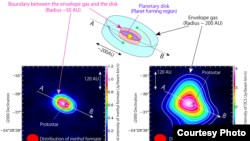We tend to think of the space between stars as empty and cold, but it's actually a reasonably filthy place, full of dust and gas.
It's not news that organic molecules like methanol form inside giant gas clouds floating out in space. They exist on tiny grains of dust that are blown through the universe on stellar winds.
The role of those stellar winds in the development of life on Earth, and perhaps on other worlds, has now become clearer, thanks to the work of Japanese researchers, using the Atacama collection of radio telescopes in Chile.
Clues to the beginnings of life on Earth
Scientists have known that those interstellar organics played a role in seeding new planets like earth with the building blocks of life billions of years ago.
What they didn't know is how much of this material comes from the cloud that forms a newborn sun and how much is being fed by stellar winds into solar systems that are still forming around their newborn stars.
Now they know.
From out there to here
The researchers from the University of Tokyo and the Japanese research institute RIKEN pointed their radio telescopes at a solar-type protostar, IRAS 16293-2422A. Floating around this central star is a ring of "stuff' in an orbit about the size of our solar system. Chances are this system looks a lot like ours did if we were able to go back in time and take a look at it in its youth.
They were able to identify the chemicals that exist in the ring that will presumably form planets, moons and all the other neighbors that live inside a solar system.
The exciting part of their work - published in the Astrophysical Journal - is that they found a significant amount of organic molecules were being fed into this ring from interstellar space. This is the first direct evidence that newly forming planetary systems are nurtured by elements from the greater universe.
We are stars indeed.









